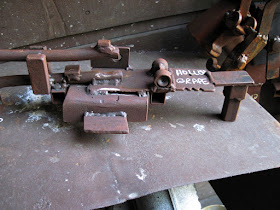Contents
▼
Sunday, December 30, 2012
Restoring the Great Bellows
Saturday, December 29, 2012
Pipe Fullers
Recently I have been making several components from structural round tube which required fullering to isolate the various segments. I hadn’t had to do this operation in quite a while so it took some time to gather a collection of tools which I recalled using for one project or another and testing them to see which would work best. I was a bit surprised to discover I could come up with so many.
As I looked at the results I felt I was getting a fresh educational experience and was now paying more attention to the finer details than when I last used them. Several clearly needed some improving of the blade edges with a die grinder or flap disc or polishing wheel. Some others needed some mechanical improvement of the hinge or other parts.
I believe after a couple of days of fiddling and observation I have a better perspective of how all the variables work to achieve the desired result and decided to write down some of my ideas before they slip away.
First there is a choice of the poser source. Will the work be done by hammer in hand or the power hammer? The treadle hammer works well with my smithing magician but the spare tire power hammer requires less effort on my part and is much faster if it can be controlled well enough. In the days when I did demonstrations I used a gate fuller in the anvil hardy quite a bit. I haven’t used the fly press much for this work. The hydraulic forging press seems too powerful to control. Probably it would work with a series of stops. Perhaps if I could spin the hot pipe really fast...
Next, what style of fullering tool to use. I use gate fullers the most and guillotine fullers a little less often. Some people don’t make a distinction but, for me, gate fullers are hinged and close on the bias and guillotine fullers close in a parallel manner whether hinged with a four bar linkage or are independent. Spring fullers haven’t worked very well in my hands at least for the tube jobs I usually do but I used one for making a specific size grape a few years ago.
The heat is important so I have to pay attention to which incandescent color heat works best at each successive stage. Going slow at first works for me. Keeping the heat localized to just the working area and getting a perfect start without any buckling takes careful attention and control. Sometimes torch heat is just the right thing. Each narrowing seems a bit less tricky.
There are a number of other critical technical details to consider. The blade throat angle is said to work best on pipe and tube between 100º and 140º and the throat opening should give “four-point” contact to squeeze the wall toward the centerline at pairs of opposing points.
The blade throat shape can be curved or straight - an ellipse or a “V”. I can’t speak to the “V” shape but I may try it in the future. The symmetry between the two blades should be close but rotating the workpiece tends to eliminate most of the error.
Blade width needs to be considered. If too narrow the tool works like a severing tool, not being able to pull enough mass into the elongating zone. If too wide the blades will have more tendency to crush and buckle the tube - similar to working too cold. I’d guess that for most of my work the blade width is about .25 x the tube outside diameter. Probably some experimentation would determine what is best for thin wall tube versus schedule 40 and 80 pipe.
It seems like the blade edge radius should be about a half circle or a bit more acutely ellipsoid, symmetrical and well polished.
The blade depth needs to be .5 x the tube outside diameter or a slight bit less if the fullering groove isn’t going to be very deep.
Straight blades aren’t generally used for hollow stock but if they are used some type of stop needs to be installed if each groove is to be the same depth. Using dies with an ellipse or “V” opening allows the die pair itself to be the stop mechanism.
The spring 2010 Hammer’s Blow is a reference worth reviewing.
Thursday, December 6, 2012
Four Bar Linkage Parallel Fuller
I drew this fuller tool plan as a place holder in my “Tools to Make” file. From time to time I actually pick an idea out and build the tool. This one will be pretty far down on the priority list as I already have a variety of fullering devices which work quite well. But you never know when this type might seem like just the thing to use. The measurements are just guesses and there may be better choices. Also, I didn’t take the time to draw the dressed radius lines on the top and bottom blades. Probably I would start with just grinding slight front and back edge radii and creating a slight concave gap between the blades so the work piece tends to seek the same centering position. Then I’d modify the edges after observing the results.
Mostly I use gate, swing arm, type fullers (which some call guillotine fullers even though the blades don’t move in the same vertical plane) in the power hammer. Occasionally I use the Smithing Magician, which seems to me to be a true guillotine fuller, or similar constructions in the fly press or hydraulic forging press. Only as a last resort do I use a hand hammer with a anvil hardy fuller tool.















